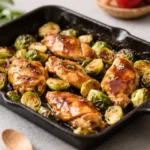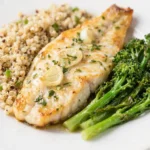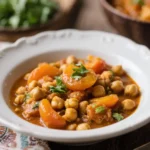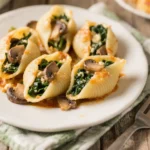One-Pan Sticky Ginger Soy Chicken & Brussels Sprouts: A Flavorful, Effortless Dinner
The History of One-Pan Cooking and the Rise of Asian-Inspired Comfort Meals
The concept of one-pan meals has deep roots in culinary traditions around the world. From rustic European casseroles to hearty Middle Eastern stews, cooking everything in a single vessel has always been a hallmark of practical, family-centered cooking. However, the modern resurgence of one-pan dishes—especially those combining bold flavors with minimal cleanup—has its origins in 20th-century American home kitchens, where time-saving techniques became essential with the rise of dual-income households.
The fusion of Asian-inspired flavors like soy sauce, ginger, and garlic into Western-style sheet pan recipes gained momentum in the early 2010s, thanks to food bloggers and meal-prep enthusiasts who sought bold, savory profiles without the complexity of traditional stir-frying. Dishes like One-Pan Sticky Ginger Soy Chicken & Brussels Sprouts emerged as perfect examples of this trend—a harmonious blend of umami-rich marinades, tender protein, and roasted vegetables that deliver restaurant-quality taste with weeknight convenience.
This particular recipe draws inspiration from classic Chinese and Japanese cooking elements, particularly the use of tamari or soy sauce for depth, fresh ginger for warmth, and honey or maple syrup for balance. By adapting these flavors to a high-heat roasting method on a single baking sheet, the dish bridges cultural techniques with modern lifestyle demands, making it a staple in health-conscious and time-crunched homes alike.
Ingredients Breakdown: Understanding Each Component
The magic of this recipe lies in the synergy between simple, accessible ingredients that come together to create complex layers of flavor and texture. Let’s explore each component:
- Chicken Thighs (Boneless, Skin-On): Preferred over breasts for their higher fat content and richer flavor, chicken thighs stay juicy during roasting and caramelize beautifully under the broiler. The skin crisps up while locking in moisture, enhancing both taste and mouthfeel.
- Brussels Sprouts: These cruciferous powerhouses are more than just a trendy vegetable—they develop a sweet, nutty flavor when roasted. Halved and tossed in oil, they char slightly at the edges, offering a pleasing contrast to the tender chicken.
- Soy Sauce or Tamari: The backbone of the glaze, providing saltiness and umami depth. Tamari is a gluten-free alternative with a smoother, richer taste, ideal for those avoiding gluten.
- Fresh Ginger: Grated or minced, fresh ginger adds a bright, zesty heat that cuts through the richness of the chicken and sauce. Its aromatic compounds enhance digestion and add an authentic touch to the dish.
- Garlic: Minced cloves infuse the entire dish with pungent sweetness when roasted, blending seamlessly with the other seasonings.
- Honey or Maple Syrup: Acts as a natural sweetener and helps create the “sticky” element by caramelizing during roasting. Honey lends floral notes, while maple syrup adds earthy warmth.
- Rice Vinegar or Apple Cider Vinegar: A splash adds brightness and balances the sweetness and saltiness, preventing the sauce from being overly heavy.
- Sesame Oil: Used sparingly for its intense nutty aroma, it elevates the overall fragrance of the dish, especially when drizzled at the end.
- Olive Oil or Avocado Oil: Used to coat the Brussels sprouts and chicken, ensuring even browning and crisp edges without drying out.
- Red Pepper Flakes (Optional): For those who enjoy a hint of spice, red pepper flakes introduce a subtle kick that complements the ginger’s warmth.
- Salt and Black Pepper: Essential seasoners that enhance all other flavors.
- Garnishes – Green Onions, Sesame Seeds, Cilantro: Fresh herbs and seeds not only add visual appeal but also contribute freshness and crunch, rounding out the sensory experience.
Step-by-Step Recipe: How to Make One-Pan Sticky Ginger Soy Chicken & Brussels Sprouts
Follow this detailed guide to achieve perfectly roasted, flavorful results every time.
- Preheat Your Oven: Set your oven to 425°F (220°C). This high temperature ensures the Brussels sprouts get crispy edges and the chicken develops a golden-brown crust.
- Prepare the Brussels Sprouts: Rinse 1 pound (450g) of Brussels sprouts, trim off the stems, and cut them in half. Remove any loose or yellowed outer leaves. Place them in a large mixing bowl.
- Season the Vegetables: Drizzle the sprouts with 2 tablespoons of olive oil or avocado oil. Add freshly ground black pepper, a pinch of salt, and optionally, a dash of red pepper flakes. Toss well until evenly coated.
- Arrange on Baking Sheet: Spread the seasoned Brussels sprouts in a single layer on a large rimmed baking sheet lined with parchment paper or foil for easy cleanup. Try not to overcrowd them—this allows proper air circulation and promotes roasting instead of steaming.
- Start Roasting: Place the tray in the preheated oven and roast for 15 minutes. This initial head start helps the sprouts begin caramelizing before the chicken goes in.
- Prepare the Chicken: While the sprouts roast, pat dry 4 boneless, skin-on chicken thighs (about 6 oz each) with paper towels. Dry skin ensures better browning. Season lightly with salt and pepper on both sides.
- Make the Glaze: In a small saucepan or microwave-safe bowl, combine:
- ¼ cup low-sodium soy sauce or tamari
- 3 tablespoons honey or pure maple syrup
- 1 tablespoon rice vinegar
- 1½ tablespoons freshly grated ginger (about a 2-inch knob)
- 3 cloves minced garlic
- 1 teaspoon sesame oil
- ½ teaspoon red pepper flakes (optional)
Warm gently over low heat or in the microwave for 30 seconds to help the honey dissolve and the flavors meld. Stir well.
- Add Chicken to Pan: After the Brussels sprouts have roasted for 15 minutes, remove the tray from the oven. Push the sprouts to the sides or back of the pan and place the chicken thighs skin-side up in the center, leaving space between each piece for airflow.
- Brush with Glaze: Using a pastry brush, generously coat the top of each chicken thigh with the warm ginger-soy glaze. Reserve about 2–3 tablespoons for later.
- Roast Together: Return the pan to the oven and roast for 25–30 minutes, or until the chicken reaches an internal temperature of 165°F (74°C) and the skin is deeply browned and slightly crispy.
- Baste and Broil (Optional for Extra Stickiness): Remove the pan from the oven. Carefully brush the chicken with more glaze. Switch the oven to broil (high setting), and return the pan for 2–4 minutes to caramelize the surface. Watch closely to prevent burning!
- Rest and Finish: Let the chicken rest for 5 minutes. Meanwhile, toss the Brussels sprouts with the remaining glaze or a drizzle of extra virgin olive oil and sesame oil for added richness.
- Serve: Plate the chicken alongside the glazed Brussels sprouts. Garnish with thinly sliced green onions, toasted sesame seeds, and optional cilantro or microgreens for color and freshness.
Tips for Perfect Results Every Time
- Don’t Skip the Skin: Skin-on chicken thighs yield juicier meat and a crisp, satisfying texture after roasting. If you must use skinless, reduce cooking time slightly and baste frequently to avoid dryness.
- Uniform Size Matters: Cut Brussels sprouts into similar sizes so they cook evenly. Larger ones can be quartered if necessary.
- Use a Rimmed Baking Sheet: Prevents juices and glaze from spilling into the oven. Lining it makes cleanup effortless.
- High Heat Is Key: Roasting at 425°F ensures caramelization, not steaming. Lower temperatures result in soggy sprouts and pale chicken.
- Reserve Glaze: Never pour all the glaze on raw chicken before baking—it can burn. Save some for tossing the veggies or drizzling at the end.
- Check Internal Temperature: Use a meat thermometer to ensure chicken is fully cooked but not overdone. Overcooking leads to dryness, especially in white meat (though thighs are forgiving).
- Let It Rest: Allowing the chicken to rest for a few minutes after cooking helps retain juices when you slice or serve it.
- Rotate the Pan: If your oven has hot spots, rotate the baking sheet halfway through cooking for even browning.
- Add Lemon Zest: For a citrusy lift, grate a bit of lemon zest into the glaze or over the finished dish.
- Crisp Up the Sprouts: For extra crunch, toss the sprouts with a little cornstarch (½ tsp) before roasting—this enhances browning without altering flavor.
Variations and Customizations
This recipe is incredibly versatile and adapts beautifully to different tastes, dietary needs, and seasonal ingredients.
- Protein Swaps: Replace chicken with salmon fillets, tofu slabs, or tempeh for a vegetarian option. Adjust cooking times accordingly—salmon takes about 15–20 minutes, while pressed tofu benefits from a longer roast to crisp up.
- Veggie Alternatives: Swap Brussels sprouts with broccoli florets, sugar snap peas, carrots, bell peppers, or green beans. Just adjust roasting times based on density—softer veggies may need less time.
- Low-Sugar Version: Replace honey with a sugar-free substitute like monk fruit syrup or reduce the amount significantly. You can also omit sweeteners entirely for a more savory profile.
- Keto-Friendly Adaptation: Use a keto-approved sweetener such as erythritol-based syrup or allulose to maintain the sticky glaze without carbs. Pair with cauliflower rice instead of grains.
- Spicy Kick: Add sriracha, gochujang (Korean chili paste), or extra red pepper flakes to the glaze. A teaspoon of chili garlic sauce works wonders too.
- Gluten-Free Option: Ensure you’re using certified gluten-free tamari instead of regular soy sauce. Most major brands offer GF versions.
- Meal Prep Friendly: Double the batch and store portions in airtight containers for up to 4 days. Reheat in the oven or air fryer to preserve texture.
- Add Nuts: Toss roasted sprouts with chopped cashews, peanuts, or almonds before serving for extra crunch and protein.
- Grain Bowls: Serve over jasmine rice, brown rice, quinoa, or noodles for a complete bowl. Drizzle with extra glaze and top with a soft-boiled egg for added richness.
- Citrus Twist: Add orange juice or yuzu to the glaze for a tangy variation. Orange and ginger pair exceptionally well.
Health Considerations and Nutritional Value
This dish strikes a thoughtful balance between indulgence and nourishment, offering several health benefits when enjoyed as part of a balanced diet.
Nutritional Highlights (Per Serving, Approximate – Serves 4):
- Calories: ~420 kcal
- Protein: ~32g (Excellent source from chicken thighs)
- Fat: ~20g (Mostly unsaturated and heart-healthy from oils and chicken skin in moderation)
- Carbohydrates: ~28g (Primarily from honey and Brussels sprouts; fiber-rich)
- Fiber: ~6g (From Brussels sprouts—supports gut health and satiety)
- Sodium: ~800mg (Can be reduced by using low-sodium soy sauce or tamari)
- Vitamin C: High (Brussels sprouts provide over 100% DV per serving)
- Vitamin K: Abundant (Essential for blood clotting and bone health)
- Antioxidants: Ginger contains gingerol, known for anti-inflammatory properties; garlic has allicin, which supports immune function.
Dietary Notes:
- Heart-Healthy Fats: Monounsaturated fats from olive oil and omega-3s in Brussels sprouts support cardiovascular wellness.
- Balanced Macronutrients: The combination of lean protein, complex carbs, and healthy fats promotes sustained energy and fullness.
- Anti-Inflammatory Benefits: Ginger, garlic, and cruciferous vegetables like Brussels sprouts are linked to reduced inflammation and improved metabolic health.
- Diabetes Consideration: Due to honey content, those managing blood sugar should moderate portion size or use low-glycemic substitutes.
- Weight Management: High protein and fiber content increase satiety, helping control appetite and reduce snacking.
Full Ingredient List
- 1 pound (450g) Brussels sprouts, trimmed and halved
- 4 boneless, skin-on chicken thighs (approx. 24–28 oz total)
- 2 tbsp olive oil or avocado oil (plus extra for drizzling)
- Salt and freshly ground black pepper, to taste
- ¼ cup low-sodium soy sauce or gluten-free tamari
- 3 tbsp honey or pure maple syrup
- 1 tbsp rice vinegar or apple cider vinegar
- 1½ tbsp fresh ginger, finely grated
- 3 cloves garlic, minced
- 1 tsp toasted sesame oil
- ½ tsp red pepper flakes (optional)
- Green onions, sliced (for garnish)
- Toasted sesame seeds (for garnish)
- Fresh cilantro or parsley (optional, for garnish)
Directions (Condensed for Quick Reference)
- Preheat oven to 425°F (220°C).
- Toss Brussels sprouts with oil, salt, and pepper; spread on a lined baking sheet.
- Roast sprouts for 15 minutes.
- Meanwhile, prepare glaze by combining soy sauce, honey, vinegar, ginger, garlic, sesame oil, and red pepper flakes. Warm slightly.
- Remove pan from oven, arrange chicken thighs in center, skin-side up.
- Brush chicken generously with glaze; reserve some for finishing.
- Return to oven; roast 25–30 minutes until chicken hits 165°F internally.
- (Optional) Broil 2–4 minutes for caramelized top.
- Rest chicken 5 minutes. Toss sprouts with reserved glaze or oil.
- Serve hot, garnished with green onions, sesame seeds, and herbs.
FAQ (Frequently Asked Questions)
Can I use chicken breasts instead of thighs?
Yes, but boneless, skinless chicken breasts are leaner and can dry out faster. Reduce roasting time to 20–22 minutes and monitor temperature carefully. Consider brining or marinating first for added moisture.
Is this recipe gluten-free?
Yes, if you use gluten-free tamari instead of regular soy sauce. Always check labels on other ingredients like vinegar or broth if used.
How do I store leftovers?
Cool completely and store in an airtight container in the refrigerator for up to 4 days. Reheat in the oven at 350°F or in a skillet to preserve texture.
Can I freeze this dish?
Yes, though Brussels sprouts may soften slightly upon thawing. Freeze in portions for up to 3 months. Thaw overnight in the fridge before reheating.
Why are my Brussels sprouts soggy?
Likely causes include overcrowding the pan, under-seasoning, or roasting at too low a temperature. Use high heat, spread in a single layer, and don’t skip the oil.
Can I make this ahead of time?
You can prep the glaze and chop the sprouts a day in advance. Assemble and roast just before serving for best results.
What can I serve with this dish?
Excellent with steamed jasmine rice, wild rice blend, quinoa, or cauliflower rice. A side of kimchi or quick-pickled cucumbers adds a refreshing contrast.
Can I cook this on the grill?
Absolutely! Grill the chicken over medium heat, basting with glaze. Roast sprouts in a foil packet or grill-safe pan alongside.
Is there a vegan version?
Yes—swap chicken for extra-firm tofu or seitan, press well, and marinate before roasting. Use maple syrup instead of honey for a fully plant-based option.
Can I use frozen Brussels sprouts?
Fresh is best for optimal texture and flavor. Frozen sprouts release excess water and may become mushy. If needed, thaw completely and pat dry before roasting.
Summary
One-Pan Sticky Ginger Soy Chicken & Brussels Sprouts delivers bold, umami-rich flavor with minimal effort—perfect for busy weeknights yet elegant enough for guests. Roasted to perfection, this balanced dish combines tender, glazed chicken with caramelized sprouts in a single pan for easy cleanup.
Packed with protein, fiber, and anti-inflammatory ingredients, it’s a nutritious, customizable meal that satisfies cravings and supports wholesome eating—proving that delicious and healthy can truly coexist.










